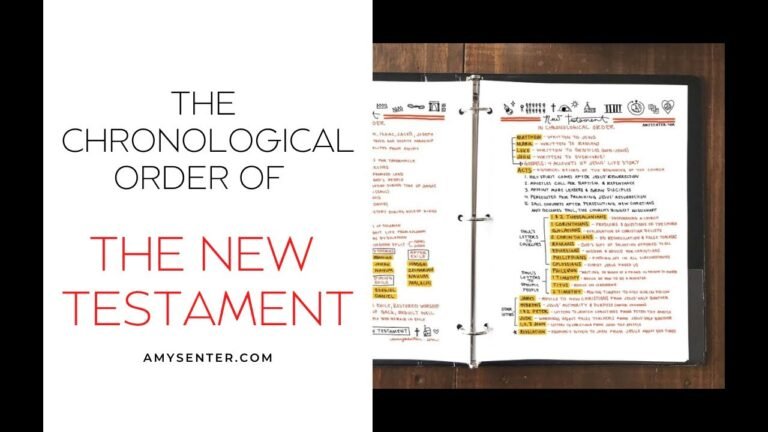Chronological Order of the New Testament Books
The New Testament is a foundational text of Christianity, comprising a diverse collection of writings that span various genres and themes. Understanding the chronological list of the New Testament books not only enhances our grasp of their historical context but also illuminates the development of early Christian thought. From the Gospels that recount the life and teachings of Jesus to the epistles that address the challenges of the early church, each book plays a vital role in shaping the faith. This exploration invites readers to delve deeper into the timeline of these sacred texts and appreciate their enduring impact on spirituality and culture.
What is the sequence of the books in the New Testament based on their chronological order?
The New Testament presents a fascinating progression of early Christian writings, with the book of Acts serving as a pivotal historical account of the church’s formation and expansion. Following Acts, the epistles begin to emerge, reflecting the teachings and guidance from apostles. Key letters include James and Galatians, which set the stage for understanding faith and community, followed by Paul’s influential correspondence with the Thessalonians, Corinthians, and Romans.
As we delve deeper into the epistles, we encounter a rich tapestry of theological discourse and practical advice aimed at various congregations. Notable letters such as Colossians, Philemon, Ephesians, and Philippians continue to shape Christian thought and practice. Together, these writings not only chronicle the early church’s journey but also lay a foundational framework for Christian beliefs that resonate through the ages.
What is the proper chronological sequence of the Bible?
To embark on a comprehensive Bible study, start with Genesis, the book that lays the foundation of creation and the beginning of humanity’s journey. Following Genesis, proceed through the historical narrative with Exodus, Leviticus, Numbers, and Deuteronomy, which collectively recount the Israelites’ journey and laws. Continue with Joshua and Judges, detailing the conquest and settlement of the Promised Land, before moving to the stories of Ruth and the united monarchy found in 1 and 2 Samuel and 1 and 2 Kings.
Once you’ve explored the rise and fall of kingdoms, delve into the accounts of 1 and 2 Chronicles, which provide a different perspective on Israel’s history. Next, read Ezra and Nehemiah to understand the return from exile and the rebuilding of Jerusalem. Conclude your journey through the Old Testament with Esther’s tale of courage and Jonah’s mission. Finally, transition to the New Testament with the book of Acts, which chronicles the early church’s growth and the spread of the gospel. This orderly approach will enhance your understanding of the biblical narrative as a cohesive story.
What are the historical books in the New Testament?
The New Testament is rich with historical narratives that provide a detailed account of Jesus Christ’s life and the early church’s development. Central to this collection are the four Gospels: Matthew, Mark, Luke, and John. Each Gospel offers a unique perspective on the life, teachings, death, and resurrection of Jesus, highlighting different aspects of His ministry and the impact it had on His followers.
Following the Gospels, the Book of Acts serves as a vital bridge between Jesus’ resurrection and the growth of the early Christian community. Written by Luke, it chronicles the spread of the Gospel through the efforts of the apostles, particularly focusing on Peter and Paul. This book not only documents miraculous events and challenges faced by the early believers but also emphasizes the transformative power of faith in action.
Together, these historical books of the New Testament form a cohesive narrative that shapes the foundation of Christianity. They invite readers to explore the profound messages of hope, redemption, and community that continue to resonate today, encouraging a deeper understanding of the faith’s origins and evolution.
Discovering the Sequence of Scripture
The journey through Scripture reveals a profound tapestry woven with divine intention and human experience. Each book, from Genesis to Revelation, unfolds a unique narrative that invites readers to explore themes of love, redemption, and faith. By examining the sequence of these texts, we uncover how ancient stories resonate with contemporary life, offering timeless wisdom and guidance.
As we delve deeper into the sequence, patterns emerge that illuminate the overarching message of hope and restoration. The connections between the Old and New Testaments highlight a continuous dialogue between God and humanity, encouraging us to reflect on our own spiritual journeys. In this discovery, we find not just a collection of writings, but a living testament to the enduring power of faith and community, urging us to engage with the profound truths that shape our lives today.
Navigating the New Testament Timeline
The New Testament timeline unfolds a rich tapestry of events that shaped early Christianity, beginning with the life and ministry of Jesus Christ. His teachings, miracles, and ultimate sacrifice laid the foundation for a movement that would transcend cultural and geographic boundaries. Following His resurrection, the apostles emerged as key figures, spreading the gospel throughout the Roman Empire, establishing communities of believers, and writing letters that would later become integral to the New Testament canon.
As we trace the timeline, the Acts of the Apostles highlights the expansion of the church, showcasing pivotal moments such as the conversion of Saul and the inclusion of Gentiles in the faith. The epistles provide deeper theological insights, addressing both challenges and triumphs faced by early Christians. This period culminates in the Book of Revelation, which offers a prophetic vision of hope and perseverance. By understanding this timeline, we gain valuable context for the teachings and events that continue to influence millions around the world today.
Unveiling the Order of the Apostolic Writings
The Apostolic Writings, a cornerstone of early Christian literature, reveal the profound teachings and experiences of the apostles as they sought to spread the message of Christ. These texts, encompassing the Gospels, letters, and Revelation, offer a unique glimpse into the formation of Christian doctrine and community. By examining the order in which these writings emerged, we can trace the evolution of early faith practices, the challenges faced by believers, and the theological debates that shaped the Church. This exploration not only enriches our understanding of the historical context but also highlights the enduring relevance of these scriptures in contemporary spiritual life.
A Guide to the New Testament’s Historical Flow
The New Testament unfolds a rich tapestry of early Christian history, beginning with the life and teachings of Jesus Christ, whose revolutionary message of love and redemption set the foundation for the faith. Following His resurrection, the Acts of the Apostles chronicles the rapid spread of Christianity through the efforts of key figures such as Peter and Paul, who journeyed across diverse regions, establishing communities and addressing challenges within the early church. The subsequent epistles offer insight into theological debates and practical guidance, reflecting the dynamic interplay between faith and culture in a burgeoning religious movement. Finally, the Book of Revelation encapsulates the ultimate hope of the Christian narrative, portraying a vision of triumph and renewal that continues to inspire believers today.
Understanding the Arrangement of Sacred Texts
Sacred texts serve as the foundation of spiritual and moral guidance for countless individuals and communities around the world. Their arrangement—often reflecting historical contexts, cultural values, and theological principles—offers profound insights into the beliefs and practices of diverse faiths. By examining how these texts are structured, from the chronological order of events to thematic groupings, readers can uncover deeper meanings and connections that enrich their understanding. This intricate organization not only enhances the text’s accessibility but also invites contemplation and dialogue, fostering a greater appreciation for the wisdom contained within.
The chronological list of the New Testament books not only enhances our understanding of the historical context in which they were written but also illuminates the development of early Christian thought. By appreciating the sequence in which these texts emerged, readers can gain deeper insights into the theological evolution and the challenges faced by the early church. This timeline serves as a valuable tool for scholars and enthusiasts alike, fostering a richer engagement with the foundational documents of Christianity.





